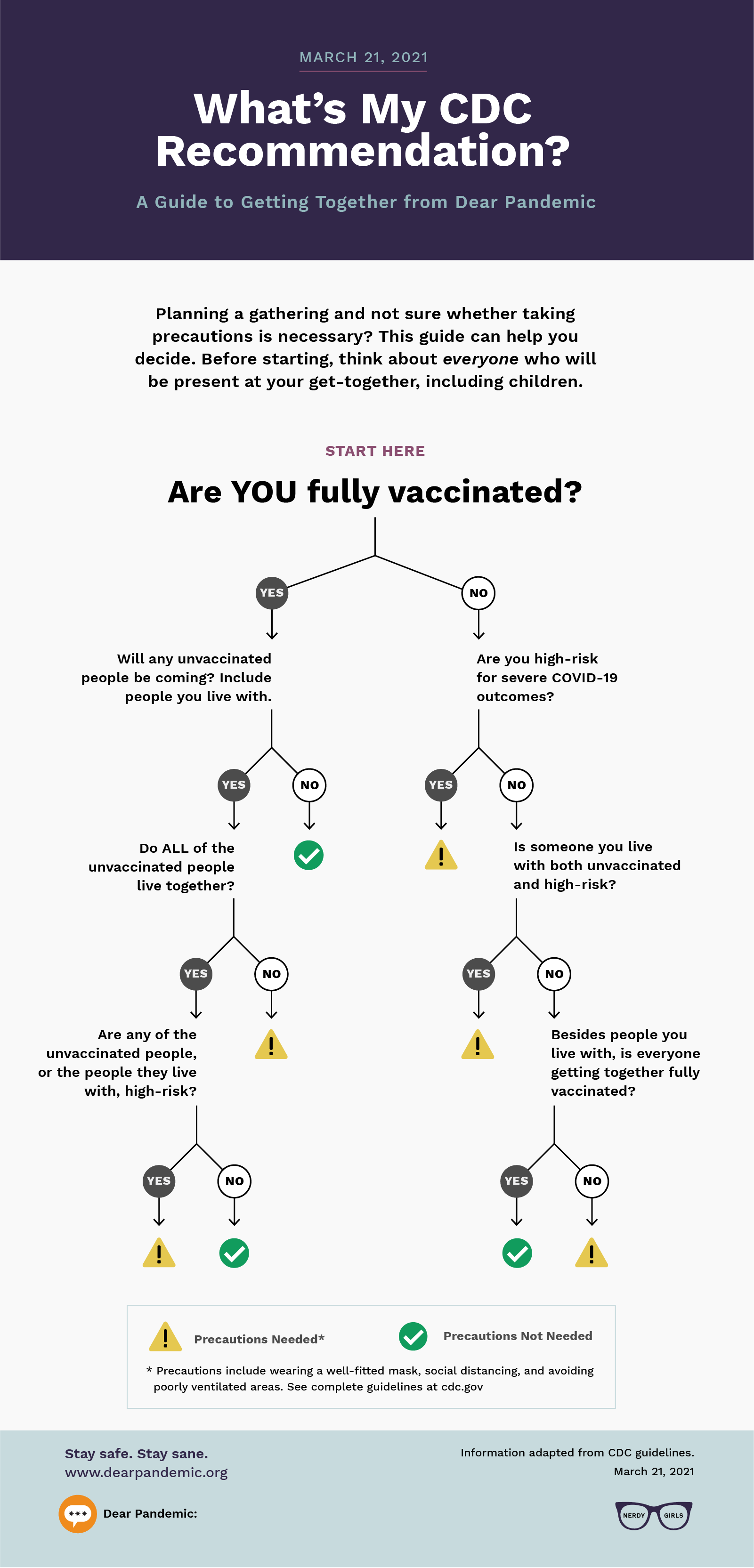Last week, the United States Center for Disease Control and Prevention (CDC) issued new guidelines stating that fully vaccinated people can safely:
🌟 Visit other vaccinated people indoors–without wearing masks or physically distancing!
🌟 Visit unvaccinated people–without wearing masks or physical distancing, as long as the unvaccinated people (and the people they live with) are low risk for severe COVID-19!
🌟 Skip quarantine and testing if they are exposed to someone who has COVID-19! But, do monitor for symptoms for 14 days, get tested, and start quarantining if symptoms develop. Remember, symptoms can be all over the map, and might be quite mild (especially after you’ve been vaccinated).
But we know you’re confused about how to apply this guidance. So we made this handy decision tree to help you decide what’s best for your upcoming gathering.
Here’s the CDC guidance. [archived link]
Let’s also revisit this Q&A on the guidance, while we’re at it.
❓ What does fully vaccinated mean?
✔️ 2 weeks following the last dose of your vaccine, you are fully vaccinated. For vaccines that only require one dose, that’s two weeks after the one dose. For vaccines that require two doses, that’s two weeks after the second dose.
And yes, there’s a discrepancy between when J&J says their vaccine produces peak effectiveness (28 days) and when CDC says you meet the “fully vaccinated” bar. CDC was likely trying to simplify their already really complex guidance so they wouldn’t have to issue it separately for every vaccine. If you’re not sure, go with the 28 days.
❓ Does this mean that fully vaccinated people can get together with also-fully-vaccinated friends indoors, without masks?
✔️ YES. Yes it does. Congratulations. Please keep the invitation list small for now.
❓ Does this mean grandparents can visit unvaccinated children and grandchildren indoors, without masks and distancing?
✔️ YES–with a bit of caution. You can visit with the unvaccinated members of 1️⃣ one household at a time, and only if the people you are visiting with–and the other people they live with–are low-risk for severe COVID-19 outcomes.
The unvaccinated members of two *different* households should still not be visiting with one another, or visiting their fully-vaccinated grandparents at the same time. Because they could still give COVID-19 to each other.
❓ Wondering who is at increased risk? This category includes unvaccinated people who are older, pregnant, or who have medical conditions including cancer, chronic kidney disease, COPD or other lung disease, Down Syndrome, heart conditions, obesity, sickle cell disease, smoking, and type 2 diabetes. Check out the whole list here.[archived link]
❓ What about the “90-day expiration” on being fully vaccinated?
✔️ There was no 90-day “expiration date” included in this latest guidance, and there remains no reason to believe that these vaccines will stop working after 90 days. At all.
❓ What about if I’ve had 1 shot of the 2-dose series? What about the approach in Canada of 4 months between vaccine doses? What if I am a COVID survivor?
❌ The United States CDC issued this guidance saying that fully vaccinated people can relax the SMART guidelines in certain situations and clearly defines fully vaccinated people: “People are considered fully vaccinated for COVID-19 ≥2 weeks after they have received the second dose in a 2-dose series (Pfizer-BioNTech or Moderna), or ≥2 weeks after they have received a single-dose vaccine (Johnson and Johnson (J&J)/Janssen ).” Having 1-dose of a 2-dose series (even if this is your government’s approach to getting more people partially covered) or having survived COVID does NOT make you fully vaccinated.
❓ What about travel?
❌ CDC did not update its guidance for travel. It still says that we should delay travel and stay home.
❓ Does this mean vaccinated individuals definitely cannot spread COVID-19 infection to others?
🤔 We still don’t have a really firm answer here. For weeks, promising reports have been accumulating which indicate vaccinated people are at least much less likely to get infected and spread COVID-19, including without symptoms; and that evidence just keeps accumulating.
Also, every week, more and more people in the highest risk groups are getting vaccinated, at least in high-income nations. This lowers the chances of really bad outcomes with any transmission from vaccinated people to unvaccinated people. Basically, fewer and fewer people who might end up with severe disease are walking around each day. But, this lingering unknown is why vaccinated people should still take precautions around high-risk people who have not yet been vaccinated, and in public.
❓ Does this mean fully vaccinated people can go out in public with no mask or distancing?
❌ NO. Not yet. CDC is still recommending vaccinated people wear masks and physically distance in public. This makes sense since you can’t necessarily know who is high-risk in settings such as the grocery store. These steps can help protect those around you if you do happen to be infected.
❓ Does this mean fully vaccinated people can attend a large gathering? Karaoke night??
❌ NO. Not yet. CDC recommends vaccinated people still avoid medium- to large-sized gatherings and poorly ventilated spaces, and also continue washing hands, wearing masks and physically distancing in public spaces. This makes sense since we are still trying to meet the goal of reducing overall transmission in the population. Wearing a mask is a signal to other people to wear a mask too.
And also because the rest of us might get really, really jealous.
❓ I’m vaccinated but my children are not. What category do I fall in?
🚸 YOU are fully vaccinated. Your children are not. Your children could still catch and transmit COVID-19, and so they should NOT be visiting with unvaccinated people without precautions.
We did a bunch of examples of how to navigate this here.
And the scientific report that supports this guidance, too.[archived link]



